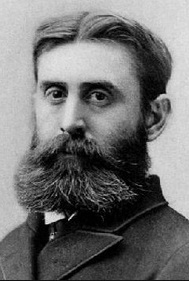 Before B.B. Warfield was professor of didactic and polemic theology in Princeton Seminary, he was professor of New Testament literature and exegesis in Western Seminary for about seven years. He appears to have loved New Testament studies and his interest continued throughout his life. He is known today for his unrelenting defense of the inerrancy of Scripture in the face of escalating opposition. Essential to his defense was textual criticism because he believed it was possible through judicious, honest, persistent, excruciatingly tedious work by scholars gifted uniquely for the task to uncover the original Bible texts, which are called the autographs—the sixty-six books as penned by their authors under the inspiration of God in infallible documents. There have been objections to Warfield’s view even among his seminary colleagues and Presbyterian friends, but behind his teaching was the rock-solid conviction that the Bible is God’s will revealed to His image bearers and He would not fallibly reveal His will; inspiration was total even to the jots and tittles of the jots and tittles but accomplished without negating the style and composition of the authors.
Before B.B. Warfield was professor of didactic and polemic theology in Princeton Seminary, he was professor of New Testament literature and exegesis in Western Seminary for about seven years. He appears to have loved New Testament studies and his interest continued throughout his life. He is known today for his unrelenting defense of the inerrancy of Scripture in the face of escalating opposition. Essential to his defense was textual criticism because he believed it was possible through judicious, honest, persistent, excruciatingly tedious work by scholars gifted uniquely for the task to uncover the original Bible texts, which are called the autographs—the sixty-six books as penned by their authors under the inspiration of God in infallible documents. There have been objections to Warfield’s view even among his seminary colleagues and Presbyterian friends, but behind his teaching was the rock-solid conviction that the Bible is God’s will revealed to His image bearers and He would not fallibly reveal His will; inspiration was total even to the jots and tittles of the jots and tittles but accomplished without negating the style and composition of the authors.
But before considering Warfield on textual criticism it is necessary to understand what textual criticism is.
When one sees the word “criticism” it is often in negative contexts such as “his criticism is discouraging” or “her critical attitude quells all joy.” However, criticism can be constructive. When a professional golfer hires a putting coach to critique his reading of greens he does so because an improvement in putting is desired and he hopes to approach perfection. Textual criticism involves examination of available manuscripts from the earliest days of textual history comparing them via honest and non-prejudicial scholarship with copies from succeeding centuries to provide the text most faithful to the autographs. Note the term “non-prejudicial scholarship,” which means critics whose presupposition is to provide the best, most accurate, and precise Bible text honoring God’s inerrant original.
An example of the importance of textual criticism will help. Assume there are 1387 extant manuscripts and fragments of a Bible passage and 462 include a word the other 925 do not. Textual critics study the variance thoroughly and deliberate to determine whether the word is original or not. The question has to be resolved; there is no choice; there is disparity; textual analysis and resolution are required. The number of texts supporting the omission of the word is an important factor, but there are other factors associated with manuscripts that complicate the process. Some manuscripts are known to have been corrupted because of scribal mistakes perpetuated in successive copies, while other texts were intentionally changed by scribes to support their errant theology. It is conceivable that the version rendered in the 462 texts is the better text. This is counterintuitive, but in textual criticism the majority are not always right. The smaller group of texts may be traceable to a more ancient source than the larger group. It could be that many or all of the texts in the majority clearly came from a source known to have been imprecisely transcribed, while the other texts in the majority had other questions regarding their history. The decision for inclusion or exclusion of the word in question must be made and the most precise selection is achieved through critical analysis.
An example of the importance of textual criticism is found in the Gospel of Mark. In the English Standard Version Bible a note prefacing the last verses of Mark says, “Some of the earliest manuscripts do not include 16:9-20.” The New International Version and New American Standard Bible both have similar notes. The King James Version, 1611, includes the verses without notation. As the years have passed more manuscripts have been discovered. All of the notations in the recent Bible versions base their comments on the fact that the earlier texts of Mark do not have the verses. Why is it important that the earlier texts omit them? Because as the years pass the likelihood of scribal error or even intentional corruption increases with each new copy. You may remember when you were a child sitting in a circle with your classmates at school. The teacher comes to you and whispers something in your ear which you are instructed to tell the student to your right with each student in the circle then following in succession. Then the teacher asks the last student to tell the class what was heard. Inevitably, what the child said bore little if any resemblance to what the first child was told. This school days game illustrates the weaknesses of auditory tramsmission and illustrates what can take place in the transmission of texts. Each scribe’s work provides opportunity for slips and omissions in the succession of copies. God inspired Moses, Jeremiah, Paul, James, and the other authors directly and inerrantly, but the scribes who copied the Bible even though dedicated to accuracy and unrelenting attention to detail suffered the same weaknesses as anyone else—they did not always accurately copy the texts. Accurate transmission is very difficult to achieve but as the Westminster Confession, 1:8, says concerning the Bible, God has uniquely and providentially directed its transmission from age to age such that its purity is exceptional. When the Bible is compared to other documents transcribed from antiquity over the centuries, there is truly no comparison because the accuracy of the Bible’s successive copies exceeds greatly that of the generations of non-biblical texts. If the Bible is to be translated into German, Russian, Mandarin, or any other language, it is prerequisite that the most faithful and precise text in the original languages must be used for the source. Honest and objective textual criticism seeks to provide the purest text for the most original Bible.
When new ancient Bible texts are discovered by archaeologists, or as in the case of the Dead Sea Scrolls by accident, they give textual critics new information to be brought into the textual archive for analysis. The Dead Sea Scrolls were discovered in 1947 by Bedouin (dessert dwellers) in eleven caves at Wadi Qumran. The numerous scrolls date to a Jewish sect called Essenes who lived about 2000 years earlier. The collection includes among other documents a single-scroll text of Isaiah as well as scrolls of the twelve Minor Prophets and at least a portion of all other Old Testament books except Esther. It was an incredible discovery that testified to the continuity and precision of the Old Testament text. Until the Scrolls were found, many of the Hebrew texts used for translation into modern languages dated to the work of the Masoretes in the Middle Ages. The Scrolls are a remarkable cache that nearly three-quarters of a century later continue to yield assistance to textual critics.
Having defined and established the importance of textual criticism, we return to B.B. Warfield.
In October 1897 B. B. Warfield published in the Presbyterian and Reformed Review his assessment of two Bible concordances. The first one dealt with the Greek text of the Old Testament, primarily the Septuagint; the second concordance addressed the Greek text of the New Testament. For any younger readers who do not know what a concordance is because digital search technology can find any word in Scripture, they are books that include all the occurrences of nearly all the words in the Bible arranged alphabetically with the passages in which they occur. Warfield commented only briefly about the first because the copy under review was the final volume of a set previously reviewed in P&RR. The book’s title is A Concordance to the Septuagint, and other Greek Versions of the Old Testament by Edwin Hatch and H. A. Redpath. The second book received the brunt of his comments. It is A Concordance to the Greek Testament according to the Texts of Westcott and Hort, Tischendorf, and the English Revisers edited by W.P. Moulton and A.S. Geden. He expressed his appreciation for the book and the compendious efforts of the editors, but he was critical because they had not included all the major extant New Testament Greek texts for their compilation. He faulted Moulton and Geden for excluding the Textus Receptus. The Textus Receptus is the original language text used by the translators of the King James Version in 1611. Even though he did not think any variations between Receptus and the texts Moulton and Geden used would prove substantial in favor of Receptus, he said “there is scientific need for inclusion of the readings of the Textus Receptus.” Warfield really is providing an indirect apologetic for Receptus because if the variations are not significant it implies Moulton and Geden’s text was an improvement over Receptus but not one of leaps and bounds. As a young man Warfield wanted to be a scientist, but when he was called to the ministry, he turned his scientific method to Biblical and theological studies. One of his students, Robert Dick Wilson, took up the scientific method with vigor and built his teaching and scholarly work upon it dedicating much of his studies to defending the authenticity of Daniel—he too assessed Receptus positively. The scientific method required gathering all the evidence available so that conclusions made from the data would be as accurate as possible. Warfield expressed his concern succinctly.
It would seem to us that the concordance would more surely have been made to contain all words which “by even a remote probability might be regarded as forming part of the true text of the New Testament,” had it included also the readings of the Receptus.
His point is that if a concordance is intended to be as good as it can be, the words compiled must reflect all the major manuscripts; the more data there is the more likely the concordance will be truly complete and as precise as possible. Likewise, turning to the New Testament Greek text, critical analysis of all the manuscripts available provides the best Greek testament. What is more, the greater the number of texts consulted for any textual work concerning the Old or New Testaments increases the probability of achieving the inerrant autographs. Even though textual criticism has been abused in the hands of higher critics, it is the science required to provide the Bible most faithful to the inerrant autographs from which modern language Bibles reveal God’s will and redemptive grace.
Barry Waugh
Notes—The header shows the beginning of the Mark 16 passage mentioned in the article. It is from The Greek New Testament, volume 1, 1857, edited by Samuel Prideaux Tregelis. This volume was used simply because I could get a good image of the Greek text from it and I know nothing of Tregelis or his presuppositions regarding New Testament textual criticism.





